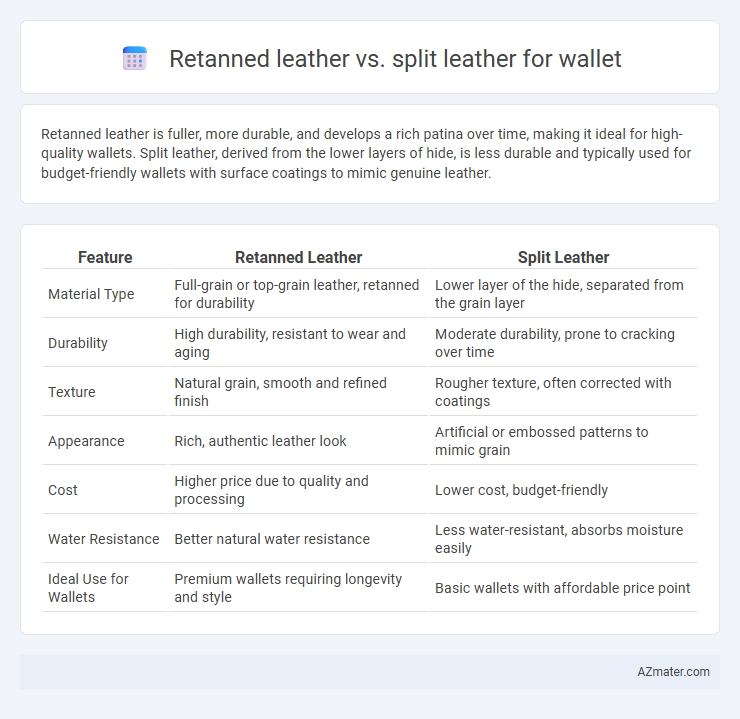Retanned leather is fuller, more durable, and develops a rich patina over time, making it ideal for high-quality wallets. Split leather, derived from the lower layers of hide, is less durable and typically used for budget-friendly wallets with surface coatings to mimic genuine leather.
Table of Comparison
| Feature | Retanned Leather | Split Leather |
|---|---|---|
| Material Type | Full-grain or top-grain leather, retanned for durability | Lower layer of the hide, separated from the grain layer |
| Durability | High durability, resistant to wear and aging | Moderate durability, prone to cracking over time |
| Texture | Natural grain, smooth and refined finish | Rougher texture, often corrected with coatings |
| Appearance | Rich, authentic leather look | Artificial or embossed patterns to mimic grain |
| Cost | Higher price due to quality and processing | Lower cost, budget-friendly |
| Water Resistance | Better natural water resistance | Less water-resistant, absorbs moisture easily |
| Ideal Use for Wallets | Premium wallets requiring longevity and style | Basic wallets with affordable price point |
Introduction to Leather Types for Wallets
Retanned leather offers enhanced durability and a smoother finish due to its secondary tanning process, making it ideal for high-quality wallets that require longevity and a premium feel. Split leather, derived from the lower layers of animal hides, is more affordable and versatile but tends to be less durable and less refined in texture compared to full-grain or retanned leather. Understanding these differences helps consumers choose wallets that balance cost, aesthetics, and durability based on their specific needs.
What is Retanned Leather?
Retanned leather is a type of leather that undergoes a secondary tanning process to enhance durability, softness, and aesthetic appeal, making it ideal for high-quality wallets. This treatment improves the leather's resistance to wear and moisture, ensuring a longer lifespan compared to untreated or split leather. Unlike split leather, which is derived from the fibrous layer beneath the grain and often lacks strength, retanned leather retains its full grain or top-grain integrity, providing a premium texture and superior durability.
Understanding Split Leather
Split leather, derived from the fibrous lower layer of hide after the top grain is separated, offers a textured and more affordable option for wallets compared to retanned leather. Unlike retanned leather, which undergoes additional tanning processes to enhance durability and flexibility, split leather often requires surface treatments or coatings to improve its wear resistance. Understanding the distinct characteristics and cost-effectiveness of split leather helps in selecting the right material for wallet craftsmanship, balancing quality and budget.
Key Differences: Retanned vs Split Leather
Retanned leather undergoes a secondary tanning process, enhancing durability and water resistance, making it ideal for high-quality wallets. Split leather, derived from the lower layers of hide, is thinner and less durable, often requiring a synthetic coating to improve appearance and texture. Retanned leather offers a more luxurious feel and better longevity compared to the more affordable but less resilient split leather used in wallet manufacturing.
Durability Comparison in Wallets
Retanned leather exhibits superior durability in wallets due to its enhanced fiber structure and resistance to wear, compared to split leather, which is more prone to abrasion and peeling over time. The retanning process strengthens the leather's natural grain, making wallets not only more robust but also better at maintaining shape and appearance under frequent use. Split leather wallets often require additional coatings or finishes to improve durability, yet they typically remain less resilient than retanned leather options.
Appearance and Texture: Which Looks Better?
Retanned leather offers a smoother, more refined appearance with a uniform texture, making wallets look polished and premium. Split leather, derived from the fibrous lower layer of the hide, has a rougher texture and a less consistent surface, often requiring additional treatments to improve its look. The distinct grain and supple feel of retanned leather generally make it more visually appealing and luxurious for wallet craftsmanship.
Performance and Longevity
Retanned leather typically offers superior durability and resilience for wallets, maintaining its structure and resisting wear longer due to enhanced tanning processes. Split leather, derived from the lower layers of the hide, is generally less durable and prone to stretching or tearing over time. Consequently, retanned leather wallets provide better performance and extended longevity compared to those made from split leather.
Cost Implications for Each Leather Type
Retanned leather for wallets tends to be more expensive due to the additional tanning process that enhances durability and water resistance, making it ideal for premium products. Split leather, derived from the lower layers of the hide, is generally more affordable but offers less strength and longevity, which can lead to higher replacement costs over time. Choosing between retanned and split leather depends on balancing upfront investment against long-term value and wear resistance.
Which Leather is Best for Wallet Making?
Retanned leather offers superior durability and a smoother finish, making it ideal for high-quality wallets that require flexibility and long-lasting appeal. Split leather, derived from the lower layers of the hide, is less durable and often treated with synthetic coatings, which can reduce breathability and strength. For premium wallet making, retanned leather is the best choice due to its enhanced texture, strength, and resistance to wear.
Conclusion: Choosing the Right Leather for Your Wallet
Retanned leather offers superior durability and a rich patina, making it ideal for wallets that age beautifully over time, while split leather is more affordable but tends to be less resilient and less breathable. Opt for retanned leather if you prioritize longevity and premium quality in your wallet investment; choose split leather for budget-friendly options with a smoother finish but shorter lifespan. Understanding these differences ensures you select the right leather type that aligns with your wallet usage and style preferences.

Infographic: Retanned leather vs Split leather for Wallet
 azmater.com
azmater.com